Sun, sea and Sicily
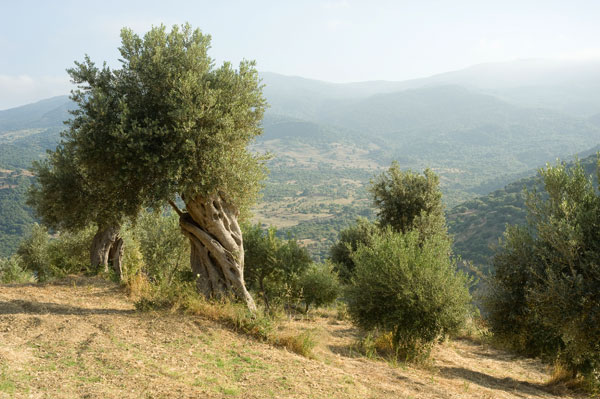
Simply sign up to the Life & Arts myFT Digest -- delivered directly to your inbox.
Like the layers of a timballo, its characteristic baked pasta dish, the essence of modern Sicilian cuisine has evolved from layer upon layer of the history of this island. It was a strategic location when the Mediterranean was the centre of the world, and each new conqueror – Greeks, Arabs, Normans, French, Spaniards – left their seeds to create the composite we have today: sun-drenched produce from the land, an abundant sea, and aromatic and flavourful dishes.
This mosaic of cultures resulted in a unique cuisine but it would not have been possible without the Mediterranean climate and terroir of the island. Within its 25,000 square kilometres microclimates range from desert-like conditions that favour the cultivated prickly pear cactus (fichi d’india), to the mushrooms, nuts and cheeses of the mountains, peaking at 3,300 metres at the top of Europe’s tallest active volcano, Mount Etna. The volcano has created a soil rich in minerals and the perfect conditions for agriculture. In the hilly inland areas, wheat has been cultivated since Roman times. Along the balmy southern coast, citrus trees grow alongside hothouses that produce some of Italy’s first spring vegetables. The three expanses of water surrounding Sicily – the Ionian Sea, the Tyrrhenian Sea and the Mediterranean – offer some of the richest fishing grounds in Italy. It is never very cold at Sicily’s lower elevations, and when spring breaks out, the air is filled with the aromas of orange blossom, jasmine and almond flowers. Foragers return with baskets of wild asparagus, fresh herbs, artichokes and mushrooms.
There is another distinctive feature of the island’s cuisine: the contrast between the sea and the interior. In the past, people did not move from one area to another with vehicles as we do today, so if they lived even a short distance from the sea, they were not likely to eat much seafood. Salted anchovies or sardines were used as seasonings but the main cuisine inland consisted of foraged and garden produce along with protein from pork, chickens, rabbits and sometimes beef. However, with more than 1,000km of coastline, the sea was and is an important resource. One quarter of Italy’s fishing boats are from Sicily, providing the rest of the country with tuna, swordfish, sardines, octopus and anchovies.
Earthy volcanic tones and the golden sun are reflected in the local produce. Vegetables have singularly good flavour, so dishes are simple, with nothing to mask their taste. Much of the simplicity of the cuisine has to do with economy too. While the nobles were feasting on elaborate French-style dishes, peasants ate what was local, seasonal and often foraged, such as the minnows called fragagghia, which are washed on to the shore in stormy weather. This cuisine is called cucina povera (peasant cooking), and is still the basis of most of today’s dishes, which often have several variations ranging from very rich to quite sparse. Historians call this cultural stratification, and a perfect example is pasta con le sarde (pasta with sardines), which in its richest form is tossed with fresh sautéed sardines, wild fennel, saffron, raisins and pine nuts, and garnished with toasted breadcrumbs. When fresh fish was not available, other versions would use salted sardines, and in its poorest form may not have fish at all, called pasta con le sarde al mare, indicating that the fish have been left at sea.
Today, the sun-baked cuisine of Sicily is known throughout the world. Since the 1800s, many products have been exported, such as salted capers, canned tomatoes and tuna, cured anchovies and olive oil. Grapes are a major export, as growing conditions are superb. The harsh climate made winemaking difficult in the past because temperatures were too high during fermentation and ageing, but in modern times with more sophisticated equipment, the region is producing notable wines; 20 have achieved DOC status. While the province of Trapani is considered Sicily’s wine region, there are contributions from all parts of the island.
In the following recipes, Sicily’s traditional dishes will transport you to a world of simple preparations, colourful ingredients and rich, complex flavours.
——————————————-
Recipes and text extracted from ‘Sicily: Recipes from the Silver Spoon Kitchen’ (Phaidon, £24.95)
——————————————-
Agrigento
The province of Agrigento is wide and stretches from the southwestern coast overlooking the temple of Selinunte to the southern exposure of Licata, and includes the Pelagie Islands that lie between Malta and Tunisia (Lampedusa, Linosa and Lampione). The cuisine is simple and fresh, and it relies on the many good products from the coast to the inland areas. At the seaside in Sciacca, you find prawns (shrimp) with conza, a condiment made with toasted breadcrumbs, often called the poor man’s cheese.
Gamberi con la ‘conza’/ Prawns (shrimp) with ‘conza’
5 tbsp olive oil
1 small onion, chopped
1 clove garlic, chopped
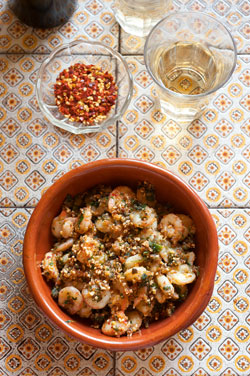
1 bunch of flat-leaf parsley, chopped
½ tsp chilli powder
500g uncooked peeled prawns (shrimp), deveined
100ml dry white wine
Salt
For the conza
2 tbsp olive oil
100g shelled almonds, chopped
100g fresh breadcrumbs
1 heaped tbs grated Parmesan cheese
Pinch of chopped flat-leaf parsley
Salt
Preparation time: 15 minutes
Cooking time: 40 minutes
Serves 6
● Heat the olive oil in a heavy pan, add the onion, garlic and parsley and cook over medium-high heat, stirring frequently, for a few minutes, then add the chilli powder and prawns. Cook, stirring occasionally, for a few minutes. Drizzle in the wine and cook for 5 minutes, until completely evaporated. Remove from the heat and season to taste with salt.
● To make the conza, heat the olive oil in a non-stick frying pan or skillet. Add all the conza ingredients, season with salt and cook over medium heat, stirring constantly with a wooden spoon to prevent the mixture from burning. It will be ready when it is golden brown. Serve immediately with the prawns.
——————————————-
Trapani
The northwestern coast of Sicily embraces the plentiful province of Trapani. Seafood, capers, olive oil and wine are exceptional, as well as artisanal ingredients. The starting point is the city of Trapani with its historic salt flats, also the home of a dish that is usually not considered Italian: couscous, served with a rich fish broth and stunningly fresh fish.
Cuscusu alla Trapanese/ Trapani-style couscous
1kg couscous
2-3 tbsp olive oil
For the fish broth
6 black peppercorns
1 onion, peeled
2 bay leaves
2 sprigs parsley
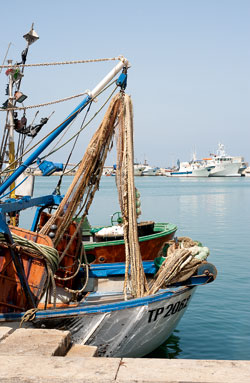
Pinch of saffron threads
2kg mixed fish, such as scorpion fish, grouper, sea bream, conger eel, cleaned
Salt
For the sauce
1 onion, very thinly sliced
1 clove garlic, peeled
2 tbsp olive oil
800g tomatoes, coarsely chopped
50g blanched almonds
2 tbsp chopped flat-leaf parsley
500ml fish stock
Salt
For the couscousier
5 peeled tomatoes, chopped
1 onion, chopped
3 bay leaves
Salt and pepper
Preparation time: 2 ¾ hours + 2 ½ hours resting
Cooking time: 45 minutes
Serves 6-8
● First, make the fish broth. Pour 1.5 litres water into a large pan, add the peppercorns, onion, bay leaves, parsley, saffron and salt, cover and cook for 15 minutes. Add the fish to the pan and simmer for 30 minutes, then remove the pan from the heat and set aside until needed.
● Meanwhile, put the couscous in a large dish. Whisk together 1.7 litres warm water, the olive oil and a pinch of salt, then sprinkle the mixture over the couscous by hand. Separate the grains with your fingertips, cover with a wet dish towel and let stand for about 30 minutes.
● Make the sauce. Pour water into a frying pan or skillet to a depth of 4cm, add a pinch of salt and heat. Add the onion and garlic clove and cook until the liquid has evaporated, then add the olive oil and cook, stirring occasionally, for 5-8 minutes, until the onion is lightly browned. Add the tomatoes, almonds and parsley, season with salt and cook, occasionally mashing the tomatoes with a fork, for 15 minutes. Remove the pan from the heat and discard the garlic.
● Lift out the fish from the broth and remove and discard the skin. Remove and reserve any bones and flake the flesh. Set aside. Strain the broth into the tomato sauce, stir in the fish stock and cook over medium heat until reduced and thickened. Remove from the heat and keep warm.
To garnish

200ml dry white wine
2 tbsp olive oil, plus extra for deep-frying
6-8 swordfish slices
6-8 baby squid, cleaned
plain (all-purpose) flour, for dusting
16 uncooked prawns (shrimp), shells intact
1 bunch of curly parsley
1 lemon, sliced
Pepper
● Put the tomatoes, onion and reserved fish bones into the lower pot of a couscousier and season with salt and pepper. Almost fill with water, bearing in mind that it must not splash the upper pot of the couscousier during cooking. Bring to a boil and cook for 10 minutes.
● Cover the perforated base of the upper pot with a well wrung-out damp dish towel, letting the four corners overhang the side. Separate the grains of couscous with your fingertips. Put the bay leaves on the damp dish towel and add the couscous. Cover with the lid and tie the opposite corners of the dish towel over it. Put the upper pot of the couscousier in place and steam for 20 minutes. Remove the lid of the couscousier, add half the sauce and all the flaked fish. Close the pan again and continue cooking for another 10-15 minutes. Turn off the heat and let the couscousier stand in the warm for 1 hour. Keep the remaining sauce warm.
● Meanwhile, prepare the garnish. Whisk together the wine, olive oil and a pinch of pepper in a large dish. Add the swordfish slices and let marinate for 1 hour.
● Heat plenty of oil in a shallow pan. Dust the squid with flour. Add the prawns and squid to the hot oil and cook for 5-8 minutes, until the prawns have changed colour and the squid are golden. Remove with a slotted spoon and drain on paper towels.
● Put the couscousier in the centre of a warm serving dish and arrange the squid, prawns, swordfish slices, curly parsley sprigs and slices of lemon around it. Discard the bay leaves and serve.
——————————————-
Palermo
A quarter of Sicilians live in the province of Palermo, along the northwest coast. The capital city is also called Palermo. It is home to the Parco Naturale delle Madonie, the natural park of the Madonie Mountains, which contains some of Sicily’s highest peaks. The park is the source of many wonderful food products, a great number of them protected by the Slow Food organisation, such as a cheese called provola delle Madonie, a unique bean called the fasola badda (badda bean) and manna, a natural sweetener extracted from ash trees.
Sfincione/ Sicilian pizza
375g plain (all-purpose) flour, plus extra for dusting
1 tsp salt
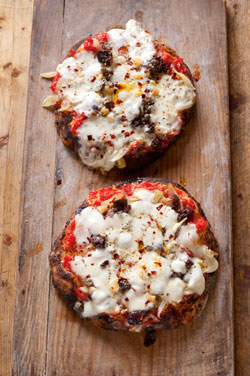
2¼ tsp fast-action (active dry) yeast
1 egg, lightly beaten
olive oil, for greasing
For the topping
2 tbsp extra-virgin olive oil, plus extra for drizzling
1 onion, thinly sliced
5-6 tomatoes, peeled and chopped
8 canned anchovy fillets, drained and chopped
50g pecorino cheese, sliced
150g mozzarella cheese, sliced
25g grated Parmesan cheese
50g pitted black olives, chopped
3tbs capers, rinsed and chopped
2 tbsp coarse breadcrumbs
Pinch of dried oregano
Pinch of dried chilli flakes
Preparation time: 1 hour + 1 hour rising
Cooking time: 30 minutes
Serves 12-18
● Sift together the flour, salt and yeast into a large bowl and make a well in the centre. Pour 250ml lukewarm water into the well, stir with a wooden spoon, gradually incorporating the dry ingredients. Add the egg and stir to a soft dough. If the dough is too sticky, add a little more flour. Turn out on to a lightly floured surface and knead for 10 minutes, or until smooth and elastic. Shape the dough into a ball, place in a bowl lightly oiled with olive oil and cover with lightly oiled cling film (plastic wrap). Let rise in a warm place for about 1 hour, until almost doubled in size.
● Preheat the oven to 220C/gas mark 7. Brush a baking sheet with oil or line with parchment paper.
● Make the topping. Heat 2 tablespoons of the olive oil in a frying pan or skillet, add the onion and cook over low heat, stirring occasionally, for 5 minutes, then remove from the heat.
● Roll out the dough on a lightly floured surface, then transfer to the baking sheet. Spread out the tomatoes evenly on top and drizzle with oil. Bake for about 18 minutes. Remove the baking sheet from the oven and sprinkle the onion, anchovies, pecorino, mozzarella, Parmesan, olives, capers, breadcrumbs, oregano and chilli flakes over the tomatoes. Drizzle with oil if necessary and bake for another 10-15 minutes, until crisp and golden.
…
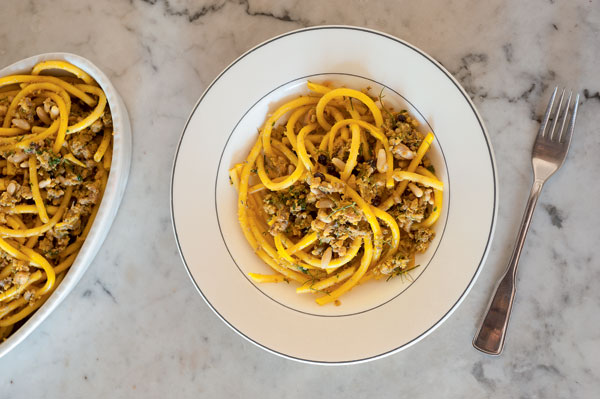
Pasta con le sarde/ Pasta with sardines
6 bunches wild fennel
500g sardines, scaled, cleaned and boned
Plain (all-purpose) flour, for dusting
150ml olive oil, plus extra for drizzling
1 clove garlic, finely chopped
1 tbsp chopped flat-leaf parsley, plus extra to garnish
Pinch of saffron threads, lightly crushed
1 onion, chopped
80g sultanas (golden raisins), soaked in warm water for 10 minutes, drained and squeezed out
80g pine nuts
4 canned anchovy fillets, soaked in milk for 5 minutes, drained and chopped
500g maccheroncini
Salt and pepper
Preparation time: 1 hour 10 minutes
Cooking time: 15 minutes
Serves 6-8
● Bring a large pan of salted water to the boil, add the wild fennel, bring back to a boil and simmer for 15 minutes. Remove with a slotted spoon and pat dry with paper towels, then chop finely. Reserve the cooking water.
● Dust half the fish with flour, shaking off the excess. Heat half the oil in a large frying pan or skillet, add the floured sardines and cook, turning once, until evenly browned, then remove from the heat.
● Heat 2 tablespoons of the oil with garlic and parsley in a shallow pan, add the remaining sardines, pour in 100ml water and simmer for 10-15 minutes. Mix the saffron with a little water in a bowl, add to the pan, season with salt and pepper and stir to break up the sardines. Simmer for 10 minutes, then remove from the heat and set aside.
● Put the onion, remaining oil and 100ml water in a shallow pan and cook for 5 minutes. Add the wild fennel, sultanas, pine nuts and anchovies and simmer for 10 minutes.
● Meanwhile, bring the reserved cooking water to the boil, add the pasta, bring back to the boil and cook for 8-10 minutes until al dente. Drain, return to the pan and drizzle with olive oil, then stir in the saffron sauce and onion and fennel mixture. Preheat the oven to 180C/gas mark 4.
● Make alternate layers of pasta and fried sardines in an ovenproof dish, ending with a layer of pasta. Bake for 15 minutes, then remove from the oven, sprinkle with parsley and serve.
——————————————-
Messina
The cuisine of Messina can be summed up in a single word: seafood, and the protagonist of that is pesce spada, swordfish. Even though it can be found in other parts of the island’s surrounding waters, the straits between Messina and the Calabria mainland are fertile grounds for swordfish. Deeper waters yield several fish brought in with nets and long lines – mullet and cod, for example. Cod has become a staple due to its abundance and mild flavour.
Pescestocco alla Messinese/ Messina-style cod
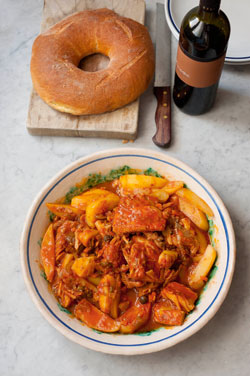
1kg plum tomatoes, chopped
100ml olive oil
1 onion, chopped
100g celery, thinly sliced
1kg stockfish (unsalted dried cod or other white fish), soaked in several changes of water for 48 hours and drained
50g capers
100g pitted green olives in brine
1kg potatoes, cut into sticks
Salt and cayenne pepper
Preparation time: 20 minutes
Cooking time: 1 hour
Serves 6
● Put the tomatoes into a shallow dish and let stand until their liquid has evaporated. Press the tomatoes through a nylon sieve (strainer) into a bowl.
● Heat the oil in a flameproof dish, add the onion and cook over low heat, stirring occasionally, for 5 minutes, until softened and translucent. Add the celery and strained tomatoes and bring to a boil, Meanwhile, cut the fish into large pieces. Add the fish, capers, olives and potatoes to the dish, season with salt and cayenne pepper and simmer for 40-50 minutes. Remove from the heat and let stand for a few minutes, then transfer to a warmed serving dish and serve.
——————————————-
Enna
The province of Enna is intensely agricultural. As well as wheat, the fertile hills provide an abundance of vegetables and pulses. In spring, artichokes are stuffed with garlic, onion, parsley and grated cheese.
Salsiccia al finocchietto arance e pane/Fennel sausages with oranges and bread
10-12 fennel-flavoured Italian sausages
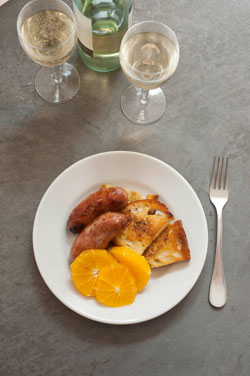
100ml dry white wine
3-4 oranges
3-4 tbsp olive oil
6 slices rustic bread
Finocchietto, finocchiella or wild fennel is a widely used aromatic herb for flavouring meat and fish dishes and mixed grills throughout southern Italy. It goes very well with lamb and, in Sicily, it is used in sausage products.
Preparation time: 20 minutes
Cooking time: 1 hour
Serves 6
● Prick the sausages with the tip of a sharp knife, put them into a shallow pan, set over medium-high heat and cook, turning occasionally, for a few minutes until evenly browned. Drizzle with the wine and cook until the alcohol has evaporated, then reduce the heat, cover and cook, turning occasionally, for about 1 hour. Add a little water if the sausages are becoming too dry.
● Meanwhile, peel the oranges, removing all traces of pith, then slice. Heat 3 tablespoons of the oil in a frying pan. Add the bread in batches, and cook over medium heat, turning once, for a few minutes until browned on both sides. Remove with a fish slice, cut in half and drain on paper towels. Add more oil to the pan if necessary for another batch.
● Divide the sausages, orange slices and bread among six plates. Serve before the sausages cool.
——————————————-
Caltanissetta
The province of Caltanissetta is shaped like an hourglass, and reaches from the Mediterranean Sea at the Gulf of Gela, an important oil refining port, to the centre of the island, where the capital city is located. Although there are some elaborate preparations in the restaurants of Gela and Caltanissetta, the local dishes are simple cucina povera at its most elemental, though sometimes with a little flair.
Pasticcio di pollo/ Chicken pie
300g plain (all-purpose) flour, plus extra for dusting
70g sugar
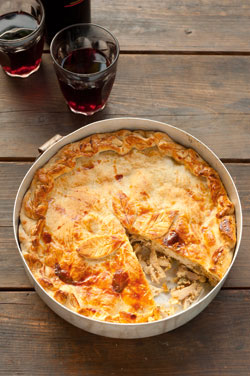
100g butter, plus extra for greasing
50g lard
2 eggs
2 tbsp Marsala
For the filling
3 tbsp olive oil
1 × 1.2kg chicken
500ml hot chicken stock
50g shelled pistachio nuts, peeled
50g shelled almonds
100g fresh breadcrumbs
2 eggs, lightly beaten
2-3tbs chopped flat-leaf parsley
1-2 tbsp drained capers, rinsed
Juice and grated zest of 1 lemon
Salt and pepper
Preparation time: 1 hour 45 minutes
Cooking time: 45 minutes
Serves 6
● Make the filling. Heat the olive oil in a shallow pan, add the chicken and cook over medium heat, turning occasionally, for 10 minutes, until lightly browned. Drizzle with 100ml of the stock. Simmer, adding more stock, a little at a time, for 40 minutes, until the chicken is tender. Remove the pan from the heat, let the chicken cool, then remove and discard the skin and cut the meat from the bones.
● Dry-fry the pistachios and almonds in a small frying pan or skillet over low heat, shaking the pan frequently, for a few minutes until just golden. Remove from the heat and chop coarsely.
● Pour the remaining stock into a bowl and soak the breadcrumbs, then drain. Mix together the breadcrumbs, eggs, parsley, capers, lemon juice and zest, chicken and chopped nuts in a bowl. Season to taste and stir gently.
● Preheat the oven to 180C/gas mark 4. Line a 24cm round cake pan with greaseproof (wax) paper and grease with butter.
● To make the dough, sift the flour into a bowl, add the sugar, butter, lard, 1 egg and the Marsala and mix well to a smooth dough. Divide the dough into 2 pieces, 1 larger than the other. Roll out each piece into a round. Put the larger pastry round in the bottom of the pan, spread the filling over it and cover with the second round. Lightly beat the remaining egg. Decorate the top of the pie with pastry trimmings and brush with the beaten egg. Bake for about 45 minutes, until golden brown. Remove from the oven and let stand for 5 minutes before serving.
——————————————-
Catania
Mount Etna, the tallest active European volcano, dominates life in Catania. A constant reminder on the skyline, with an ever-present plume of smoke drifting up to the sky, it commands a reverent, careful respect. Even in the face of imminent danger, the fertile land is irresistible for everything from blood oranges, nuts and prickly pears (fichi d’india), to grapes for wine.
The best pistachios come from Bronte, a village on the western side of Mount Etna. The Bronte Red or Pistacchio Verde di Bronte DOP are encased by a hard shell, and the interior nut is emerald green with a red husk. Most gelaterie in Sicily offer pistachio gelato, and the authentic recipe can be identified by the colour, a rather drab green. Neon green mixtures have surely been enhanced by an artificial colouring. The annual pistachio sagra, or festival, is on the second Sunday in October.

Gelato al pistacchio/ Pistachio ice cream
750ml milk
2 tbsp vanilla sugar
100g unsalted shelled pistachios, finely chopped
6 egg yolks
175g caster (superfine) sugar
Preparation time: 25 minutes + 20 minutes freezing
Cooking time: 15 minutes
Serves 6
● Bring the milk to a boil, stir in the vanilla sugar and remove the pan from the heat. Put the pistachios into a bowl and stir in a few tablespoonfuls of the milk until combined, then stir in the remaining milk. Beat the egg yolks with the sugar in another bowl until frothy, then add pistachio mixture and pour into a pan. Bring the mixture just to a boil over moderate heat, stirring constantly, then immediately remove the pan from the heat.
● Let cool, then pour the mixture into an ice cream maker and freeze for about 20 minutes or according to the manufacturer’s instructions.
——————————————-
Ragusa

Once considered off the beaten path for tourists, the province of Ragusa has now become a true foodie destination. Home to exquisite ingredients, many young chefs that left to try their hand in other parts of the world have now returned to their roots and are attracting international attention.
Sweets rise to a new level here. Modica chocolate is a world unto itself, and it has contributed to the lovely assortment of pastries you will find there. Another local classic is mustazzola (a filled biscuit or cookie, rich with honey and almonds). While the half-moon-shaped panzerotti are usually savoury, much like a calzone, here ricotta panzerotti are short pastries filled with sweetened ricotta.
Panzerotti di ricotta/ Sweet ricotta pastries
500g plain (all-purpose) flour, plus extra for dusting
100g caster (superfine) sugar
100g butter or 100g lard
Vegetable oil, for deep-frying
Icing (confectioners’) sugar, for dusting
Unsweetened cocoa powder, for dusting
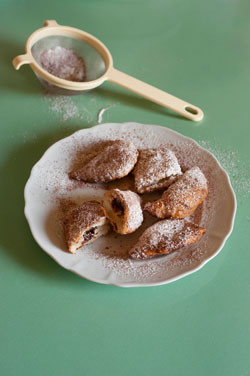
For the filling
1kg sheep’s milk ricotta cheese
250g caster (superfine) sugar
200g dark (semisweet) chocolate, chopped
Preparation time: 50 minutes
Cooking time: 1 hour
Serves 6
● First, make the dough. Sift the flour into a mound on a counter and make a well in the centre. Add the sugar, butter or lard and enough water to mix to a smooth, elastic dough. Divide the dough into 2-3 pieces and roll out each piece into a thin sheet on a lightly floured surface.
● To make the filling, rub the ricotta through a sieve into a bowl. Add the sugar and beat well until thoroughly incorporated and the mixture is creamy. Stir in the chocolate.
● Put small mounds of the filling evenly spaced on one side of a sheet of dough, then fold over the uncovered side and press around the filling with your fingers. Cut out the panzerotti into squares or crescents with a cookie cutter. Repeat with the remaining sheets of dough and filling until they are all used.
● Pour the oil into a large frying pan or skillet to a depth of about 10cm and heat. Add the panzerotti, in batches if necessary, and cook for 8-10 minutes, until golden brown. Remove with a slotted spoon and drain on paper towels, then let cool. Dust with icing (confectioners’) sugar and unsweetened cocoa powder before serving.
——————————————-
Siracusa
Siracusa is one of Sicily’s most ancient cities, founded by the Corinthians in 734BC, and at that time it rivalled Athens in importance. The oldest part of the city is a picturesque island called Ortigia, the source of fresh water and of the myth of Artemis and Arethusa. Nearby, the Teatro Greco, with seating for 15,000 spectators, still stands.
Coniglio dei nebrodi in agrodolce/ Sweet-and-sour Nebrodi rabbit
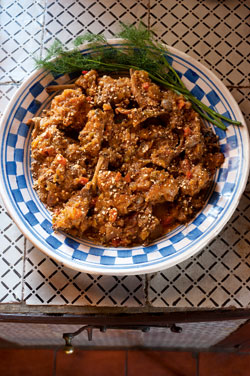
300ml red wine vinegar
1 × 1.5kg rabbit, cut into pieces
3 tbsp olive oil
2 onions, thinly sliced
1 celery stalk, chopped
1tbs tomato purée
250g giardiniera, chopped
4-5 apples, peeled, cored, sliced and blanched in acidulated water
3 tbsp sugar
50g shelled hazelnuts, roasted and chopped
Wild fennel, to garnish
Salt
Preparation time: 30 minutes + 30 minutes soaking
Cooking time: 2 hours
Serves 4-6
● Stir 200ml of the vinegar into a bowl of water. Add the pieces of rabbit and let soak for 30 minutes, then drain and pat dry.
● Heat the olive oil in a large non-stick frying pan or skillet, add the pieces of rabbit and cook over medium-high heat, turning occasionally, for 8-10 minutes, until evenly browned. Remove the pan from the heat.
● Pour water into a small frying pan or skillet to a depth of 1.5cm, add a pinch of salt and set over medium-low heat. Add the onions and celery and cook for about 15 minutes, until the onions have become translucent.
● Mix the tomato purée with 200ml hot water. Transfer the pieces of rabbit to a large pan, add the tomato purée mixture and the onion and celery mixture, cover and simmer for 45 minutes. Stir in the giardiniera and the apples, re-cover the pan and simmer for another 45 minutes.
● Heat the remaining vinegar in a small pan, then remove from the heat, stir in the sugar and add to the pan of rabbit. Season to taste with salt and remove the pan from the heat.
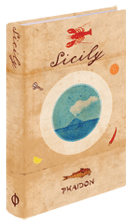
● Transfer the stew to a serving dish and let cool, then sprinkle with the hazelnuts and garnish with the wild fennel.
——————————————-
Financial Times reader offer:
Sicily cookbook
Get 30 per cent off Sicily (plus p&p) via Phaidon.com or by ringing 020 7843 1234 and quoting coupon code SFT001. Offer ends May 4 2013
Comments